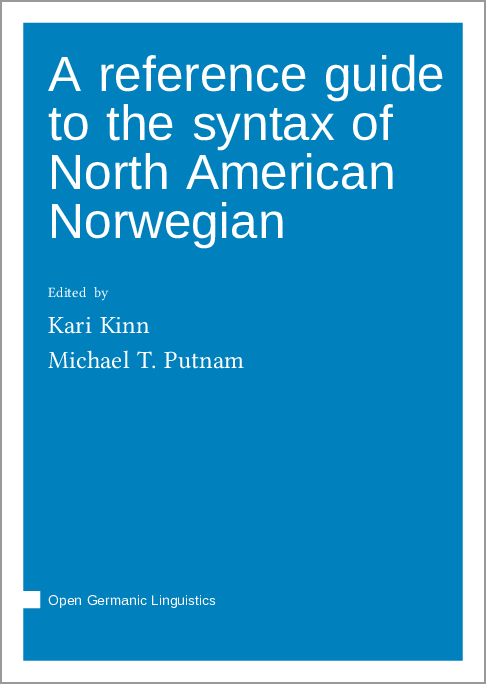We log anonymous usage statistics. Please read the privacy information for details.
A reference guide to the syntax of North American Norwegian
Synopsis
North American Norwegian (NAmNo) is a diasporic heritage variety of Norwegian spoken primarily in the Upper Midwest of the United States. NAmNo has been in use since the mid-19th century, but it is now moribund. This volume serves as a synopsis of previous research focusing on the syntax of this language while also expanding upon these findings in key domains. Beyond the rich empirical description of facets of North American Norwegian syntax, the chapters in this volume also contribute to theory-building efforts from a Minimalist perspective. Kari Kinn and Michael T. Putnam begin the volume introducing the language and the theoretical preliminaries of aspects of the Minimalist Program found throughout the volume. The introductory chapter is followed by a detailed history of the emigration and language during the settlement period by Arnstein Hjelde. Brita Ramsevik Riksem and Mari Nygård explore the intricacies of agreement in determiner phrases, while Yvonne van Baal investigates its properties of definiteness. Kari Kinn rounds out the contributions on aspects of determiner phrases by taking a closer look at how possession is licensed in these structures. Shifting focus to the verbal and clausal domains, Kristin Eide’s chapter addresses the syntactic reflexes of tense, modality, and aspect in NAmNo. The structure of non-finite clauses is the theme of Michael T. Putnam and Åshild Søfteland’s contribution, which is followed up by Merete Anderssen, Helene R. Jensberg, Terje Lohndal, Björn Lundquist, and Marit Westergaard’s treatment of verb second (V2) word and finite verb placement. Ida Larsson and Kari Kinn analyze argument placement in NAmNo, focusing particularly on subject shift, object shift, and verb particles. Michael T. Putnam and Kari Kinn conclude the volume with an epilogue, highlighting the key empirical and theoretical findings of these contributions as well as charting a course for future research on the syntax of NAmNo. In summary, this volume is the first of its kind whose mission is not only to simultaneously summarize previous and ongoing research on the syntax of NAmNo, but to also demonstrate the important role heritage language syntax contributes to our understanding of the acquisition, attrition, change, and maintenance of heritage language syntax.
Chapters
-
Part I: Introduction and background
-
The syntax of North American NorwegianIntroduction and theoretical preliminaries
-
Norwegian emigration and language
-
Part II: The nominal domain
-
Agreement in North American Norwegian determiner phrases
-
Definiteness in determiner phrases in North American Norwegian
-
Possession in determiner phrases in North American Norwegian
-
Part III: The verbal and clausal domains
-
Tense, modality and aspect in North American Norwegian
-
Non-finite complementation in North American Norwegian
-
Verb second word order and finite verb placement in North American Norwegian
-
Argument placement in North American Norwegian: Subject shift, object shift and verb particles
-
Part IV: Conclusion
-
Epilogue




